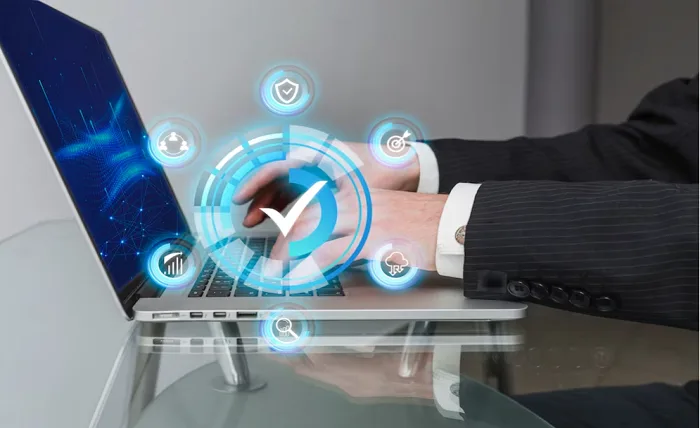Microsoft Endpoint Manager (MEM) is a comprehensive solution that integrates services and tools designed for IT professionals to ensure the security and management of devices and applications across diverse endpoints, including phones, laptops, desktops, and servers.
At the core of MEM is Microsoft Intune, a leading mobile device management (MDM) and unified endpoint management (UEM) platform. Intune enables remote management of devices, covering iOS, Android, and macOS, with capabilities to validate compliance and deploy apps, features, and settings via the cloud.
Notably, MEM eliminates the need for on-premises infrastructure, offering a streamlined, cloud-based approach to device and app management, accessible through a user-friendly web portal.
Key Trends in Device Management for 2024 and Beyond
- Integration of Artificial Intelligence (AI)
Automation of routine tasks: AI is automating repetitive tasks in device management, reducing the workload on IT staff, and freeing them to focus on more strategic initiatives.
Enhanced security through threat detection: AI-driven analysis can identify unusual device usage patterns and swiftly detect potential security breaches, helping organisations to stay ahead of the curve and mitigate risks.
Insights into user behaviour: AI can provide valuable insights into user behaviour, such as device usage patterns and app preferences. This information can be used to make proactive management decisions, such as optimising device performance and security configurations.
- Rise of the Internet of Things (IoT)
Managing connected devices: Device management is expanding beyond traditional mobile devices to include the diverse landscape of IoT devices. This includes everything from smart sensors and wearables to industrial equipment and connected vehicles.
Expanding device management scope: The proliferation of IoT devices necessitates effective management and security measures for an array of connected devices. This poses both challenges and opportunities for device management providers.
- Shift to Cloud-Based Solutions
Advantages of scalability and flexibility: Cloud-based device management solutions offer scalability and flexibility, allowing businesses to adjust their capabilities as needed. This is particularly beneficial for organisations with fluctuating device counts or changing needs.
Remote management capabilities: Cloud-based solutions enable IT staff to manage devices remotely, regardless of their location. This enhances accessibility and operational efficiency, especially for businesses with distributed workforces.
Anywhere accessibility: The cloud allows for access to device management tools from anywhere, simplifying device management tasks and reducing reliance on physical infrastructure.
- Greater Emphasis on User Privacy
Addressing public awareness: Device management providers are prioritising user privacy in response to increasing public awareness of data privacy issues. This is reflected in their product development and marketing efforts.
Implementation of encryption: Encryption measures are employed to protect user data, balancing effective device management with user privacy. This ensures that sensitive data is protected from unauthorised access, even if a device is lost or stolen.
Privacy-by-design principles: Device management software is increasingly incorporating privacy-by-design principles. This means that privacy is considered at every stage of the development process, ensuring that user data is protected by default.
- Rise of Unified Endpoint Management (UEM)
Integration of multiple device types: UEM solutions consolidate the management of diverse devices, including smartphones, tablets, laptops, desktops, and IoT devices, into a single platform. This simplifies device management tasks and provides a more consistent user experience.
Simplified device management: UEM solutions streamline device management tasks by providing a centralised platform for managing all devices. This can help organisations to reduce costs and improve efficiency.
Consistency across digital devices: As businesses adopt a wider range of digital devices, the demand for UEM solutions is expected to grow. UEM solutions can help organisations to ensure that all devices are managed consistently, regardless of their type or operating system.
- Focus on User Experience
Meeting user expectations: As mobile devices become central to daily life, users expect a seamless and hassle-free experience. Device management solutions are evolving to meet these expectations.
Enhancing software intuitiveness: Device management software is becoming more intuitive, with user-friendly interfaces and simplified workflows. This makes it easier for users to manage their devices and resolve any issues that may arise.
Robust user support: Device management providers are prioritising robust support mechanisms, such as online knowledge bases, chatbots, and phone support. This helps users to get the help they need quickly and easily.
Microsoft Intune for Device Management
- Timely updates and comprehensive device monitoring: Ensure that devices are consistently updated and closely monitored to proactively maintain IT infrastructure health and performance, minimize vulnerabilities, and optimise functionality.
- Modern, cloud-based provisioning and application packaging: Expedite the onboarding process and get users up and running quickly with a streamlined approach to deployment that enhances efficiency, reduces downtime, and ensures a seamless user experience.
- Consistency, stability, and reliability across the managed environment: Achieve consistency, stability, and reliability throughout the managed environment with standardised configurations and settings across devices, contributing to a cohesive and predictable IT landscape that fosters a stable and reliable infrastructure that supports uninterrupted business operations.
- Security against cyber threats for data, devices, and identities: Safeguard data, devices, and user identities from cyber threats with robust security measures, including secure configurations, identity protection, and device-level security protocols, to mitigate the risk of cyberattacks and unauthorized access.
- Reports and analytics with actionable insights: Generate detailed reports and analytics to gain actionable insights into key areas, empowering organisations to make informed decisions, identify trends, and address potential issues before they escalate. By leveraging data-driven intelligence, organisations can continuously optimise device management strategies for enhanced performance and security.



